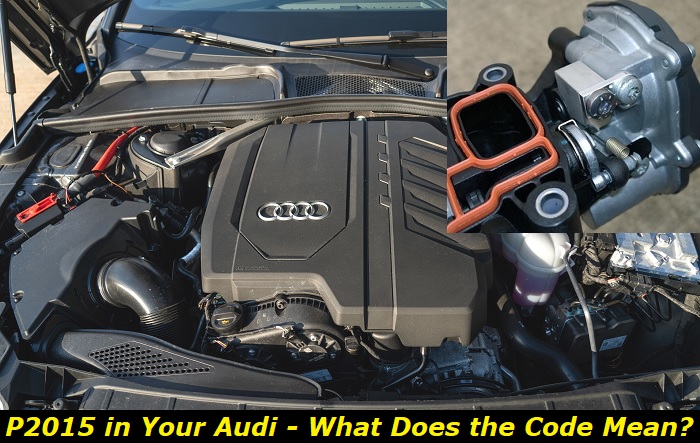Audi is one of the top German luxury brands in the world. Its demand is driven primarily by its vehicle's revolutionary designs, performance, comfort, and reliability. The company also benefits from the quality that its parent, Volkswagen, is known for.
P2015 code highlights
- Level of urgency:Medium
- Possible culprits:Intake manifold
- Price for repair:$50 - $350
- If neglected:Harsh engine work, loss of power
- DIY repairs:Possible
- Can you drive?Yes

The Meaning of the P2015 Fault Code in Audi Cars
The P2015 fault code in Audi cars points to a problem with the performance of the Bank 1 intake manifold runner. This component, found in the intake manifold system, is responsible for regulating air intake and controlling airflow.
The bank 1 intake manifold runner consists of a flap that opens and closes based on engine load and speed, allowing more or less air to enter the combustion chamber depending on driving conditions. If the flap fails or becomes stuck due to wear or debris buildup, it can cause an imbalance in air flow distribution which would trigger the P2015 fault code.
The Bank 1 Intake Manifold Runner is located towards the front of the engine bay and must be replaced if its performance is affected by any issue. Diagnosing and repairing this component requires special tools as well as knowledge of Audi-specific engine systems.
It's important to note that attempting repair without proper tools and expertise may further damage the engine and should be avoided. Professional service is recommended when it comes to the P2015 fault code in Audi cars.
Common Causes of the P2015 Fault Code in Audi Cars
Although the P2015 fault code directly points to a potential issue in the bank 1 of the intake manifold runner, do remember that the data generated by your car's onboard computer is influenced by many factors. Therefore, when diagnosing this problem, you must also consider the said elements.
Among the most common factors triggering the P2015 warning in Audi vehicles are the following:
1. Bank 1 Intake Manifold Runner Sensor
The sensor in the bank 1 intake manifold runner of Audi is an important component for ensuring the correct operation of the engine. It helps measure airflow levels, allowing for precise measurements that can be used to adjust fuel delivery rates and other engine settings. When this sensor is out-of-position or faulty, it can cause a variety of issues such as misfires, poor idle quality, and even stalling. This can lead to a P2015 fault code being triggered on Audi cars.
To diagnose a misaligned or faulty bank 1 intake manifold runner sensor, a visual inspection should first be done to look for any obvious signs of damage such as cracks or broken components.
If no visible damage is present, then using a multimeter to measure the resistance across the terminals can help to determine if the sensor is functioning correctly. If there is a noticeable anomaly in resistance when compared to a known good sensor, then it may be necessary to replace it.
In some cases, simply repositioning the sensor or cleaning any dirt or debris from its connection points can restore its proper functioning. To ensure this process is done correctly, using a specific tool designed for that purpose and following manufacturer-recommended guidelines should be followed.
We strongly recommend the expertise of a qualified technician on this matter to ensure that the new position of the sensor is accurately measured and verified so that no further issues are encountered. Once complete, all connections should be re-checked and tightened as needed before starting up the engine again. After this procedure has been completed, the fault code should not be present and the engine should run smoothly.
It is important to remember that, when dealing with any type of sensor issue, taking a methodical approach and following the manufacturer's instructions should be done in order to ensure the best possible results.
If it can't be solved using this approach, then replacement may be necessary. With that being said, it is still important to check all connections and wiring before replacing any parts as this can often help solve issues without having to purchase new components. Following these steps will help keep your vehicle in top running condition for years to come.
2. Open Connection or Shorting in the Wiring Harness
When diagnosing the possibility of an open connection or shorting in the wiring harness that is triggering the P2015 fault code, a visual inspection, and a multimeter should both be used. If there is visible damage to any wires, they should be replaced immediately as this could cause further issues with the car's electrical system. Additionally, all connections must be properly checked with a multimeter to confirm they are in working order.
To start, disconnect each wire from its respective connector, then set the multimeter to Continuity Test mode and check each wire individually. If there is no continuity present when two ends of the same wire are connected with the meter probes, then it shows that the wire has been damaged somewhere in between and needs replacing.
In terms of solutions, if any wiring harness is found to have an open connection or shorting, it should be replaced immediately. This can often be done without removing the entire harness and instead just replacing individual wires as they are damaged.
Any parts that are being replaced should come from a certified source in order to ensure that they are compatible with the specific make and model of the car. If this is not possible, then professional help must be sought in order to correctly diagnose the issue and replace faulty components.
Once all necessary repairs have been carried out, the vehicle should be retested with a diagnostic scanner to confirm that the P2015 fault code has been cleared and that no further issues remain.
3. Stuck Intake Manifold Runner
Diagnosing a potential stuck intake manifold runner that may be triggering the P2015 fault code in Audi cars is possible through visual inspection, interpreting specific symptoms, and using tools. Initially, check for any visible signs of damage to the air intake system such as hose deterioration or detached connectors.
Next, assess whether there are abnormal sounds when the engine is running. If a vacuum leak exists, you will likely hear whistling noises coming from the area around the intake manifold runners.
Additionally, you can use a scan tool to check for any pending codes stored in the ECU (Engine Control Unit). If your results show an open circuit or shorted circuit error during testing, it could mean that one of the intake manifold runners isn't working correctly. To confirm, you can use a multimeter to measure the voltage of each runner and check if they match.
If your diagnosis reveals that one of the intake manifold runners is stuck, then it's time to take some corrective action. The most common repair involves replacing the faulty part with a new or refurbished one from an Audi dealership or qualified mechanic.
Be sure to inspect all surrounding parts for signs of wear and tear before putting everything back together. If possible, we also recommend running an engine performance test after replacing the faulty component to guarantee that the problem has been fixed correctly and prevent any further issues.
Additionally, be sure to reset any fault codes stored in the ECU after completing repairs. Following these steps will get your Audi back in top form and help prevent further issues from occurring.
On the other hand, if you're lucky enough and the only reason for the stuck intake manifold is dirt buildup, you may be able to clean the component with an aerosol cleaner and a brush. Be sure to follow the instructions on the can carefully, as this approach may not always be successful.
For more severe cases, it may be necessary to completely remove the intake manifold runners for repair or replacement. This process can be complex, so it is recommended that you have a professional mechanic handle the job if possible.
Additionally, keep in mind that preventive maintenance is the key when dealing with any type of engine issue, such as regular inspections and tune-ups, to help prevent similar problems from occurring in the future.
Conclusion
There are many other things that could indirectly activate the P2015 fault code in your Audi car. The most common though are the ones discussed here, and these should give you a good starting point when diagnosing the probable cause of the issue.
Take note that while some of the solutions mentioned here may look easy in writing, dealing with the crucial electrical and mechanical components of your vehicle, especially those that have to do with the engine, come with certain risks.
So, make it a point to bring your Audi to its official service center or your trusted mechanic when finding a cure for the P2015 fault code to avoid further complicating things as you fix your auto.
About the authors
The CarAraC research team is composed of seasoned auto mechanics and automotive industry professionals, including individuals with advanced degrees and certifications in their field. Our team members boast prestigious credentials, reflecting their extensive knowledge and skills. These qualifications include: IMI: Institute of the Motor Industry, ASE-Certified Master Automobile Technicians; Coventry University, Graduate of MA in Automotive Journalism; Politecnico di Torino, Italy, MS Automotive Engineering; Ss. Cyril and Methodius University in Skopje, Mechanical University in Skopje; TOC Automotive College; DHA Suffa University, Department of Mechanical Engineering






Add comment